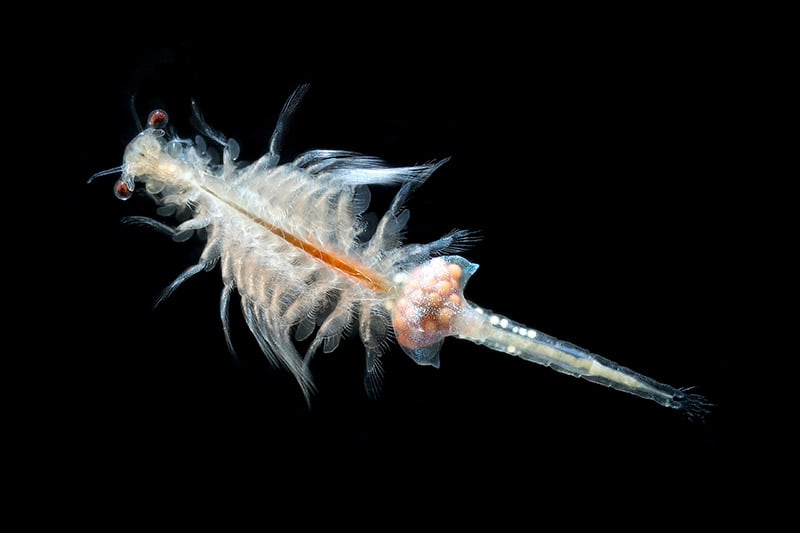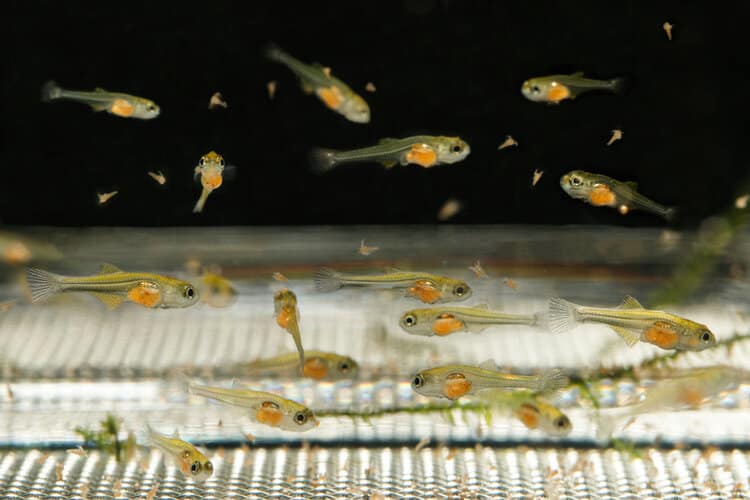Introduction to Fish Fry
Fish fry are newborn baby fish! They can be divided into two categories: livebearers and egglayers.
Livebearer fry such as swords, platys, mollies, and guppies are generally much bigger than egglayer fry and therefore can be fed baby brine shrimp or microworms from the beginning.
Most egglayers fry are too small to eat baby brine shrimp when they first hatch so other alternatives must be used. Usually the fry can be fed pulverized flake food, infusoria, micro worms, and rotifers. Hard boiled egg yolks can be squeezed through coarse cloth also. When they get old enough the food of choice is baby brine shrimp or microworms.
See below for information on each type of food.
Brine Shrimp

Brine shrimp are a favorite and easily obtainable live food for all kinds of fish!
Unfortunately, only the largest fish fry are able to eat baby brine when they are first needing to eat food on their own. For example, Bettas can usually begin eating baby brine when they are 3 or 4 days old, but Dwarf Gouramis are usually not big enough for at least a week.
Live and frozen brine shrimp are generally readily available at your pet store, as well as frozen baby brine shrimp.
Hatching Brine Shrimp Eggs:
Brine shrimp eggs can be purchased either by themselves or with a culturing kit which usually includes pre-measured salt packets, a container, and tubing for air pump aeration.
Brine will hatch at room temperature in water that has a specific gravity of about 1.020 – 1.040. (The specific gravity measurement corresponds to the amount of salt in the water – add salt to increase the specific gravity). One can purchase salt for marine aquariums and add about 1/2 cup per gallon of water for sea water or up to 1 cup salt per gallon for brine water. If you don’t have a hydrometer (for measuring the specific gravity) use about 3/4 cups per gallon to be somewhere in between, or about 1.030.
In lieu of purchasing the salt one can use this formula:
12 ounces non-iodized salt (rock salt)
2 ounces Epsom salt
1 ounce bicarbonate of soda
1 gallon water
(If the eggs are from the Great Salt Lake, add 1 teaspoon of borax)
Put 1/4 teaspoon of brine shrimp eggs per gallon salt water and aerate to keep the eggs in motion. At 65 degrees F. the eggs will hatch in about a week, at 70 degrees they will hatch in two days, at 80 degrees they will hatch in about 1 day.
Raising Brine Shrimp to Maturity:
Raising the shrimp to maturity can be accomplished by using large aquariums with lots of algae. Putting the container in the sun, outside or in a window can help. The specific gravity should be kept between 1.025 and 1.030. A heavy production of “green water” or filamentous algae in the rearing tanks should feed large numbers of shrimp to adulthood. Other additions include Pablum, lettuce, and other organic substances which are used for the production of infusoria.
When the brine shrimp reach maturity they will pair off and eggs will start floating to the top. The eggs can be netted and dried for later hatching.
Microworms (and other Nematodes)
The Greek word “Nema” means “thread”, so these worms (nematodes) might also be referred to as “threadworms”!
Nematodes are minute, colorless, unsegmented, smooth, cylindrical worms that are rarely more than 1/16 of an inch in length.
Microworms are usually used as a substitute for baby brine since they are roughly the same size. They are highly nutritious and are abundant at times when other food sources may be hard to get. They are often fed with a feeding ring with a hanging net of coarse cotton cloth attached.
Culturing Nematodes:
Starter cultures can sometimes be purchased at your local pet shop or biological supply houses. They can also be collected by boring a 1/2 inch hole in a potato and burying it in a garden or wood lot for about one week. At this time any worms feeding on the potato can be collected by washing off the potato in clean spring water and then filtering the water through a coarse cloth or muslin.
Ongoing culturing can be accomplished in shallow, flat, watertight containers kept between 68 and 85 degrees Fahrenheit (75 degrees is recommended). The area should be dark but not completely without light. Old dried up cultures or frozen cultures can be used because of the worms’ ability to exist for long periods under unfavorable conditions. Worms will grow only on the surface so the medium should be about 1/4-1/2 inch or so deep, just enough to keep it from drying out. Boiled cereals can be used for the medium and yeast should always be added to it.
The culture usually lasts about two or three weeks before fermenting occurs and starts to smell bad. At this time a new culture should be started and the old discarded.
Some aquarists will keep cultures going by removing half every few weeks and adding new medium. Thus cultures can be kept going indefinitely.
Culture mediums: several can be used including Soya flour, Pablum, semolina, oatmeal, and cornmeal. Yeast needs to be added always. You can also add wheat germ and milk can be used instead of water to boil the cereal.
Several culturing recipes are given below.
Cornmeal
Place cornmeal in the container to a depth of about 1/4 inch. Mix dry yeast into slightly warm water until the solution is quite milky. This water-yeast solution can then be added to the cornmeal until “puddles” remain over part, but not all , of the surface of the cornmeal. Now you can add worms.
Pablum
Mix three parts Pablum with one part dried yeast. Add enough water to form a thin paste. Pour about 1/2 inch deep into the container (jar or pan). Add worms and let it stand for a couple of days at room temperature.
Oatmeal
Mix four parts boiled oatmeal to one part dried yeast and dilute with water or milk to a thin paste. Place 1/2 inch layer in the container, add the worms, and cover securely.
Rotifers
As the fish fry become larger, they seek out larger food and so rotifers come next in their diet after infusoria.
Rotifers are found in the same environments as infusoria but are larger and, although most are microscopic, the larger ones appear as specks to the naked eye. The cilia surrounding the mouth opening move in such a manner as to gather in food which looks like a rotating wheel. The Latin word “rotifer” means “wheel bearer” and hence the name as used by early zoologists.
Many aquarium articles have been written on the usefulness of rotifers for the raising of fish fry and how one can expect to raise a high percentage of the spawned fishes and end up with quality specimens from feeding rotifers. Rotifers are also used as a conditioning food to induce adult fish to spawn.
Collecting Rotifers:
To collect rotifers one usually uses a net constructed of fine, soft, sheer fabric of plain weave. These nets work well in open water areas but in areas where vegetation abounds masses of the submerged plants can be removed and washed out in pans or buckets of clear pond water before using the net. Larger animals can be removed with coarse screens also.
Make sure and collect the pond water at the same time as it is the best medium to be used later to culture more rotifers.
Rotifers can be kept alive for only a short period of time if they are abundant in the collecting jars unless they are aerated or kept cold in the refrigerator. They can also be frozen for use later on.
Culturing Rotifers
They can be cultured in much the same way as infusoria using a hay infusion, or by using infusoria as food. Different species have their own requirements (some are actually predatory and eat other rotifers) but for a mixed species collection the same method as used with infusoria will probably work.
“Stable tea” is sometimes used as a medium for culturing rotifers. It is prepared by boiling one and one-half pints of fresh horse manure in a quart of water for one hour and then straining the mixture. Then two quarts of rain or spring water is added and the resulting mixture is left standing (uncovered) for two days. This can be inoculated with infusoria or green water and will be ready for the introduction of rotifers in about a week or ten days.
Featured Image Credit: Toxotes Hun Gabor Horvath, Shutterstock
